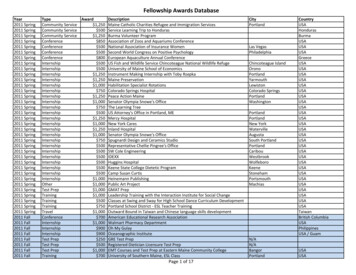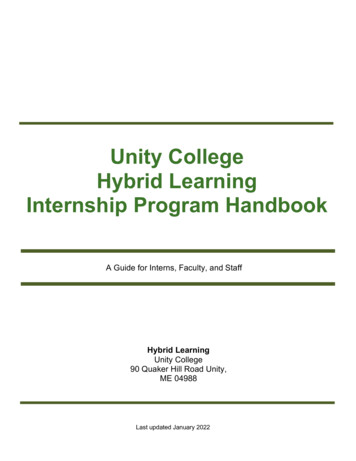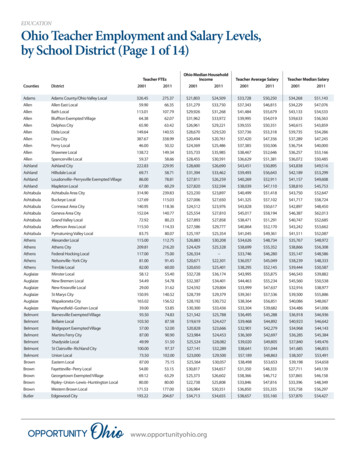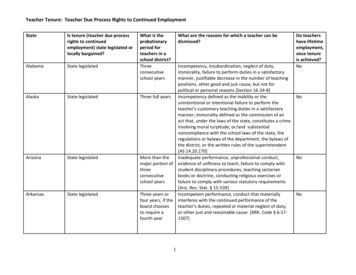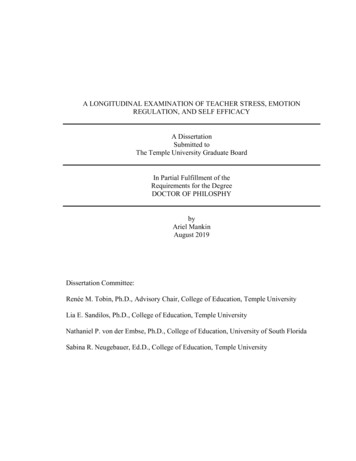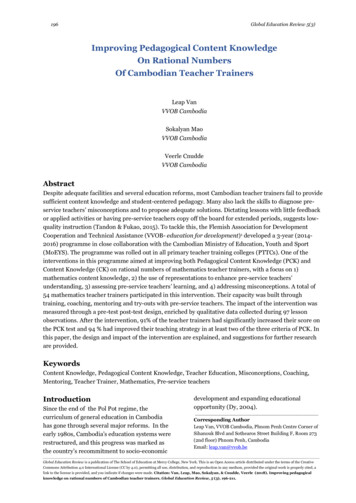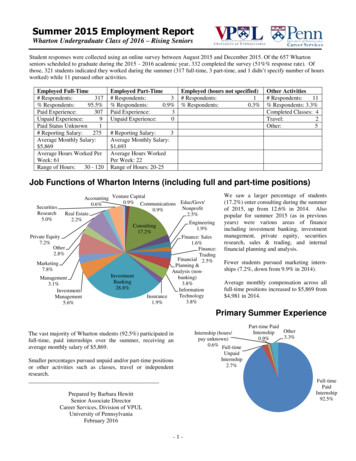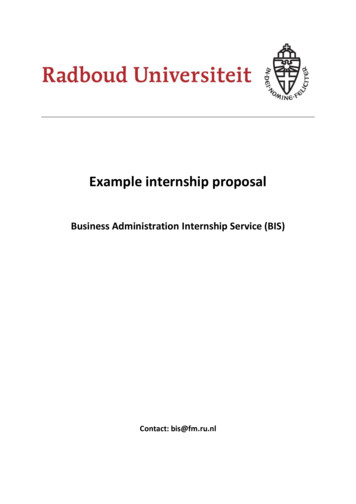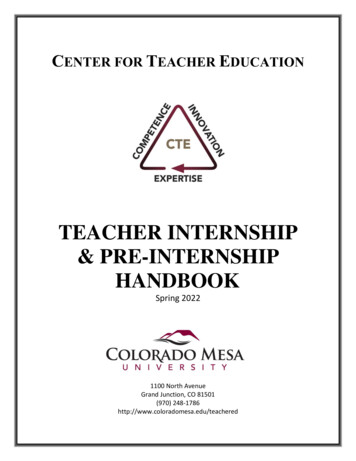
Transcription
CENTER FOR TEACHER EDUCATIONTEACHER INTERNSHIP& PRE-INTERNSHIPHANDBOOKSpring 20221100 North AvenueGrand Junction, CO 81501(970) 248-1786http://www.coloradomesa.edu/teachered
TABLE OF CONTENTSFIELD EXPERIENCES . 1CONNECTING THEORY WITH PRACTICE.1PRE-INTERNSHIP FIELD EXPERIENCE PLACEMENT .1INTERNSHIP FIELD EXPERIENCE PLACEMENT .4THE TEAM-TEACHING INTERNSHIP MODEL .5EXPECTATIONS OF TEACHER CANDIDATES . 6INTERNSHIP CALENDAR.6ELIGIBILITY FOR INTERNSHIP .6PROFESSIONAL DISPOSITION .6ASSESSMENT PROCESS .9APPLYING FOR STATE LICENSURE. 9RESPONSIBILITIES OF MENTOR TEACHERS, SCHOOL ADMINISTRATORS, AND UNIVERSITYINSTRUCTORS/SUPERVISORS . 9RESPONSIBILITIES OF THE MENTOR TEACHER .10LIABILITY ISSUES AND LEGAL STATUS OF TEACHER INTERNS .11SUBSTITUTE TEACHING DURING INTERNSHIP .11RESPONSIBILITIES OF THE BUILDING ADMINISTRATOR IN CHARGE OF PLACEMENTS .12RESPONSIBILITIES OF THE UNIVERSITY SUPERVISOR .12COUNSELING & GROWTH PLANS . 13Forms including Portfolio Guidelines and Field Evaluation Forms are available separatelyon the CTE website at ergraduate.htmlR:\TeacherEd\Handbooks\Intern Handbook\Intern Handbook Spring 2022.docxii
Field ExperiencesConnecting Theory with PracticeField experiences are a critical component of the Colorado Mesa University (CMU) Teacher EducationProgram. These experiences give teacher candidates the opportunity to relate principles and theories toactual classrooms and schools by creating meaningful learning experiences. The culmination of theseexperiences is the teaching internship where teacher candidates fully participate in a team-teachingapproach in the classroom. As teacher candidates gain experience and knowledge, they transition intothe lead instructor position (expected by mid-semester).Throughout the program, candidates complete a minimum of 800 hours, fulfilling a minimum of 140hours in pre-internship and a minimum of 600 hours during internship. Placements generally occur inthe immediate region of Mesa County Valley School District 51. Placements can also be made acrossColorado’s Western Slope in CMU’s regional service area. Candidates interested in a regional placementmay join our Elementary Regional Cohort Program or may work closely with their Center for TeacherEducation (CTE) advisor to obtain permission for an individual regional placement.Pre-Internship Field Experience PlacementThe pre-internship typically coincides with methods courses. Each of the licensure programs offer adifferent pre-internship experience. In this field placement, teacher candidates will develop teachingproficiency and broaden their content knowledge.Elementary Pre-Internship:Undergraduate Elementary Licensure students should have all of their non-education requirementscompleted before starting their pre-internship. Elementary teacher candidates will complete 140 hoursduring their pre-internship. The course sequence for the elementary pre-internship is as follows:CreditsEDUC 475 Classroom Management for K-121EDUC 441 Methods of Teaching Language and Literacy: Elementary3EDUC 451 Methods of Teaching Mathematics: Early Childhood/Elementary 3EDUC 461 Methods of Teaching Science/Social Studies3EDUC 471 Educational Assessment for K-121ARTD 410 Elementary Art Education Methods3Field Hours8060-Secondary Pre-Internship:Undergraduate Secondary Licensure students typically enroll in education and final content coursesduring their pre-internship semester. Secondary teacher candidates will complete 140 field hours duringtheir pre-internship. The education course sequence for the secondary pre-internship is as follows:EDUC 442 Integrating Literacy Across the CurriculumEDUC 475 Classroom Management for K-12EDUC 497 Content Methodology PracticumEDUC 497(A-E) Methods of Teaching Secondary—EDUC 497 (A-E) is only offered in the fall semester and may be completed prior to theCredits4132Field Hours6080-pre-internship semester with the consent of the secondary faculty advisor.1
Early Childhood/Early Childhood Special Education:The dual Early Childhood/Early Childhood Special Education (EC/EC SPED) Licensure students shouldhave all of their non-education requirements completed before starting their pre-internship. EC/EC SPEDteacher candidates will complete 140 field hours during their pre-internship. The course sequence forthe EC/EC SPED pre-internship is as follows:CreditsEDUC 378 Technology for K-12 Educators1EDUC 441 Methods of Teaching Language and Literacy: Elementary3EDUC 451 Methods of Teaching Mathematics: Early Childhood/Elementary 3EDUC 461 Methods of Teaching Science/Social Studies3ECSE 450 Individual Behavior Support and Guidance3Field Hours8060-K-12 Pre-Internship:Each K-12 licensure program has unique course sequencing and field hour requirements. Students inK-12 education programs complete both education and major requirements during their pre-internsemester(s). For more information regarding content requirements and sequencing, students shouldconsult their degree plan.Art K-12 Teaching students complete 140 pre-internship field hours over two semesters in thefollowing classes:CreditsField Hours**ARTD 410 Elementary Art Education Methods3**ARTD 410L Field Studio Experience in Elem Art Education Methods140ARTD 412 Secondary Art Education Methods340EDUC 442 Integrating Literacy Across the Curriculum360EDUC 475 Classroom Management for K-121**ARTD 410 & Lab is typically completed the semester prior to internshipKinesiology K-12 Teaching students complete 160 field hours at a variety of placements sitesduring the following courses:CreditsField HoursKINE 497 Pre-Internship in Physical Education3120EDUC 342 Pedagogy and Assessment: Secondary and K-12320EDUC 343 Teaching to Diversity320Music Education students complete a minimum of 180 music field hours over several semesters atvarious placement sites during the following courses:CreditsField HoursEDUC 343 Teaching to Diversity320Pre-Education Music courses MUSA 240 Introduction to Music Education230 MUSA 340 Teaching Elementary & General Music330 MUSA 440 Teaching Vocal Music K-12335 MUSA 441 Teaching Instrumental Music K-12335 MUSA 442 A/B Teaching Special Ensembles: Choral or Instr.2302
Initial Teacher Licensure, Graduate Program, Pre-Internship:Students who have already obtained their bachelor’s degree can pursue elementary, secondary, or K-12physical education licensure through our intensive Initial Teacher Licensure (ITL) program. ITL teachercandidates complete 340 field hours during the pre-internship semester. The ITL pre-internship coursesequence for the elementary, PE and secondary ITL programs are as follows:Credits Field HoursITL ElementaryEDUC 592AITL Elementary Pre-Internship4200EDUC 587Elementary Reading and Language Arts Theory and Methodology K-6 380EDUC 588Elementary Mathematics Theory and Methodology K-6360EDUC 589Elementary Science and Social Studies Theory and Methodology K-63ITL SecondaryEDUC 592BEDUC 580 (A-E)EDUC 580EDUC 584EDUC 570ITL Secondary Pre-InternshipSecondary Instructional MethodsSecondary Instructional Methods Across the CurriculumSecondary Literacy Methods Across the CurriculumClassroom ManagementITL K12 Physical EducationEDUC 592C - ITL K-12 Physical Education Pre-InternshipEDUC 580 F – Methods of Teaching Secondary Physical EducationEDUC 580 – Secondary Instructional Methods Across the CurriculumEDUC 584 – Secondary Literacy Across the Curriculum423312008060-43332008060COLORADO MESA UNIVERSITYCENTER FOR TEACHER EDUCATION3
Internship Field Experience PlacementThe Center for Teacher Education (CTE) at Colorado Mesa University is dedicated to the mission ofproviding teachers who are competent in subject matter, are expert in professional teaching, and have apassion for innovation within their classrooms. The knowledge, skills, and aptitudes being developedand practiced during the teacher education program culminate in the teaching internship with teachercandidates demonstrating proficiency in each of these areas by the conclusion of the internship.The teaching internship requirements are aligned to the Colorado Teacher Quality Standards and the 10InTASC standards. By the completion of the program, interns demonstrate competency on thesestandards through field evaluation and portfolio and performance assessments. Early Childhood,Elementary, Secondary, and ITL students complete the edTPA portfolio and performance assessment.K-12 students complete a Program Proficiency Portfolio and a Final Intern Presentation (FIP).The internship courses for each endorsement area are as follows:CreditsField Hours6630030012600Early Childhood Education with SPED Endorsement (ages 0-8)EDUC 499A Teaching Internship and Colloquia for K-2ECSE 499 Teaching Internship and Colloquia for ages 3-5Elementary Endorsement (grades K-6)EDUC 499C Teaching Internship and Colloquia: ElementarySecondary Endorsement (grades 7-12)Endorsements: English Language Arts, Mathematics, Social Studies, General Science, or K12 SpanishEDUC 499G Teaching Internship and Colloquia: Secondary12600K-12 Endorsement (Art, Music, or PE – grades K-12)EDUC 499D Teaching Internship and Colloquia: ElementaryEDUC 499H Teaching Internship and Colloquia: Secondary66300300(The semester is split equally between an Elementary and a Secondary placement for PE and Music)Initial Teacher Licensure (ITL) EndorsementsElementary Endorsement (grades K-6)EDUC 599 A Directed Teaching – Elementary Education12600Secondary Endorsement (grades 7-12)Endorsements: English Language Arts, Mathematics, Social Studies, Spanish, or General ScienceEDUC 599 B Directed Teaching – Secondary Education12600K-12 Physical Education EndorsementEDUC 599C - ITL 3: Directed Teaching126004
The Team-Teaching Internship ModelIn the team-teaching internship model, the mentor teacher and the teacher intern enter into a teachingand learning partnership. This model fosters collaborative efforts and draws on the strengths of eachpartner in the development of curriculum and the practice and implementation of effective teachingstrategies. The key components of the team-teaching internship model include collaborative teachingapproaches, reduced student-teacher ratios, peer support groups at host schools, and increasedprofessional development opportunities.Collaborative Teaching ApproachesThis model fosters a collaborative and cooperative classroom environment in which the teacher internand mentor teacher work as a team in planning, managing, instructing, and assessing the educationalprogram. Strengths and talents of the teachers and interns are carefully considered in the partneringprocess. The ideal partnership allows the intern to take on progressive levels of responsibility for thefirst half of the internship; by midterm, the intern is responsible for the entire day of classes.Reduced Student/Teacher RatiosWith pressures on improving student learning and meeting individual student needs, the team-teachingmodel creates additional resources for an increased level of learning and participation by schoolstudents. For example, while the teacher intern provides whole-class instruction, the mentor teacher isable to work with at-risk students who would benefit from the guidance and direction provided by theexperienced teacher.Peer Support GroupsThe teacher internship model at CMU encourages a supportive and collegial environment in whichteacher interns can share their ideas, successes, concerns and questions with each other. Throughregular participation in D2L discussions and/or on-campus meetings, teacher candidates confer witheach other, supervisors and faculty on topics pertaining to student teaching. Additionally, theorientation and colloquium sessions offered during the intern semester provide a forum for students tointeract with teachers and educational experts from local school districts regarding best practices, firstyear teaching, and the licensing and hiring processes.Lead Teaching and Professional Development OpportunitiesWhile the teaching internship model stresses a team-teaching approach, opportunities for the intern toassume sole-teaching responsibility are essential. These periods of time allow the teacher candidate tostrengthen their instruction and classroom management knowledge and skills in a supervisedenvironment. Furthermore, this time enables the mentor teacher to participate in various professionalopportunities such as curriculum development or team meetings.Under this model, a licensed teacher must be in the classroom or at close proximity for ease of access atall times. Student teachers may not be tasked to substitute teach without meeting CTE’s guidelines forsubstitute teaching, and only during the last quarter of their internship. More on CTE’s substituteteaching policy for interns and more regarding legal responsibilities concerning the candidate, mentor,and school can be found in the Liability Issues and Legal Status of Teacher Interns section, on page 11.5
Expectations of Teacher CandidatesInternship CalendarColorado Mesa University teacher interns follow the district/school calendar for teachers; the CMUsemester class schedule is followed only for registration deadlines, final projects and grade posting.Interns must spend an entire semester in the classroom. Student teachers will be expected to start theirplacements on the first day that their mentor teacher is scheduled to start the semester and completetheir internship on the day that their mentor teacher is scheduled to end the semester. Please note thatthese dates will not necessarily correspond to CMU’s academic calendar. If a district or school follows anachievement calendar, the candidate must confirm start and end dates with their program coordinatorprior to starting their internship.Eligibility for InternshipBefore students can begin their internship, they must fulfill the following criteria: Students must earn a “B” or better in all education classes. Teacher candidates may not progressinto their internship if they have not passed all of their methods courses with a “B” or better. Students must maintain the required overall and content area GPA of 2.8. A grade of “C” or better must be earned in all required courses, unless otherwise stated. Students must take the Praxis licensure exam for their content area before beginning their preinternship and must pass their licensure exam prior to the start of internship.o Students can take this exam at any time during the program. This exam is a componentof state licensure and students are encouraged to take it early so in the event that theirscore does not meet the state requirement, they have the opportunity to retest.o For information on the content exams required for specific Teacher Education programssee ired-testing.html.o Information on Colorado Department of Education (CDE) content testing requirementscan be found at http://www.cde.state.co.us/cdeprof/content tests. Students must have a current CPR/First Aid certification throughout their internship semester.All education students are made aware of this requirement at the onset of their programs. Students must clear a CDE background check prior to their student teaching. Students who receive unsatisfactory evaluations may be removed from their placements. Students who do not make satisfactory progress in the program, as defined in the AdvisingHandbook, must meet with their Program Coordinator before continuing enrollment inEducation courses. Overall academic performance and dispositional factors will be evaluated bythe department, and students may be asked to take corrective steps before students may begiven permission to re-enroll in Education courses.Removal from Internship PlacementCTE has support systems in place to promote a successful internship experience for all candidates.Removing a candidate from an internship placement can occur in instances where the intern/pre-internhas been asked to leave the assignment, is failing to make satisfactory progress in coursework or oncontent exams, has excessive absences, and/or demonstrates a lack of professionalism.If removal occurs, the department leadership will discuss the situation with the candidate, supervisor,and the team at the school site. Possible outcomes may include: a grade of “C,” “D,” or “F” may beissued; the intern/pre-intern may be permitted to withdraw; or the intern/pre-intern may be withdrawn6
administratively. See the Counseling and Growth Plan section for more information on the candidateremediation policies. Another internship assignment may be considered, following department reviewand a written action plan. If a Teacher Education candidate withdraws from the program and laterwishes to return, he/she must reapply to the Center for Teacher Education. The candidate shouldcomplete a time-out form when withdrawing from CTE.Professional DispositionThe Colorado Mesa University Center for Teacher Education evaluates interns on professional behavioras described below. These behaviors must be demonstrated through attitudes, behaviors andrelationships that will be observed by mentor teachers, university supervisors, and ProgramCoordinators.Attendance/PunctualityAll pre-interns and interns will work their mentor’s daily schedule, following the district’s teacher workcalendar. Candidate evaluation includes attendance and punctuality. Some districts will require you toattend staff meetings, extracurricular activities, district board meetings, open houses, and in-servicedays. Your attendance at these functions demonstrates a professional attitude and commitment.Absences: Absences are generally unacceptable. We expect 100% attendance during the internshipsemester. If an unavoidable absence situation does arise, you must communicate with your ProgramCoordinator in advance for approval. Unavoidable absences, such as illness, must be communicated assoon as possible. Interns must communicate the absence ahead of time when possible or the day-of, atthe latest, to the following people: CMU Program Coordinator Supervisor Mentor Teacher School Secretary or Assigned School AdministratorMore than three absences may impact your ability to successfully complete the internship semester. Allabsences must be noted on the internship time log. Interns must receive approval from their ProgramCoordinator prior to planning absences. Absence approvals must be filed with the UndergraduateCoordinator.Preparation for Internship Absences: Lesson plans must be ready for your mentor teacher. Collaboratewith your mentor to determine the preferred format for the lesson. Remember that the mentor ANDstudents are counting on you to provide the curriculum so students can continue to learn.DressInterns are evaluated on dressing professionally and appropriately. For example, when in schools, menshould wear collared shirts with slacks; women should wear slacks or skirts. Jeans are not acceptableattire for men or women. Your dress is an important way for you to distinguish yourself from thestudents in the schools. In addition, you should always wear your official Colorado Mesa Universitynametag or host school ID if one has been provided. You may experience casual dress during yourobservations and internship, but you must remember that you represent Colorado Mesa University andare held to the standards set by the Center for Teacher Education. Your Program Coordinator is availableto discuss any questions you may have about appropriate dress during your internship.7
Demeanor/AttitudeA positive and enthusiastic disposition in your work, both on campus and in school placements, must beobserved during your internship and will be a factor in evaluations. While at school placements, becomea part of the school community by introducing yourself to school administration, faculty, support staffand students. Maintain a professional and positive attitude toward students, faculty, support personnel,administration, parents, and the community. Become familiar with school policies and practices andwork in a manner consistent with them. Become thoroughly acquainted with classroom facilities andlearn the procedures used by the mentor teacher, including instructional materials available in theschool and the school district. Finally, become familiar with the community and its relationship to theeducational program. Understanding the context of your students is critical for teachers.CommunicationPractice appropriate communication skills with peers, professors and school personnel. Your priorcoursework has prepared you for this. Whether working with peers, professors, teachers or any otherpersonnel, ask specific questions when you have them, be positive, be open to constructive feedback,and be tactful. Interns must make themselves available for joint meetings with their mentor, supervisor,and Program Coordinator as necessary during their classroom placement. Also, always notify youruniversity supervisor, mentor or coordinator of potential issues that may hinder a successful experience.Social Media and Student PicturesCMU Teacher Education students are NOT to post pictures of students to the internet. School Districtsobtain media releases before posting pictures of children, and take on the liability of any images used. Asa student teacher, you are not permitted to take on that liability and/or to use student images for socialmedia or any other publication. Video images are used in edTPA assessment, but require waivers and arenot disseminated. More information on edTPA video assessment and waivers can be found on theedTPA.com website under the Preparing Videos page.Teacher candidates are expected to comport themselves professionally in field settings. As such, picturesof any individuals in a school setting should not be taken or used for personal purposes. Teachercandidate are also advised to use good judgment when posting to social media in general. Teachers areoften held to a higher standard, and it will benefit you to use discretion when posting.Theory in PracticePractice and apply to each of your field experiences the academic and pedagogical standards learnedthroughout your coursework in the Teacher Education Program. Reflect on how these standards applyto you and the cooperating or mentor teacher(s).In summary, students in the Center for Teacher Education program are expected to always demonstratethe following professional dispositions: Attendance & Punctuality Collegiality Reliability Planning for contingencies Reflective practice Commitment to the profession Initiative Desire to improve own teaching performance Desire to help students learn Sensitivity to diverse learners with diverse needs Ability to receive feedback positively—you are still learning Tact and judgment with peers, students, instructors, and social media8
Assessment ProcessAll teacher candidates participate in a comprehensive assessment process designed to provide a pictureof their performance and progress toward demonstrating proficiency in the Colorado Teacher QualityStandards. The following assessment components and processes are used to evaluate the teacherintern's performance. Submitting PRAXIS content licensure exam scores prior to beginning student teaching.placement, and passing the PRAXIS licensure exam prior to the start of internship.Academic course grades based on traditional and performance-based assessments.Fulfillment of GPA requirements, credit hour completion, and portfolio completion.Documentation of at least 800 field experience hours as recorded on Field Experience Time Logs(includes internship hours).Informal observations and evaluations by mentor teachers, principals, and university supervisors.Formal evaluation of standards proficiencies by mentor, and university supervisor duringteaching internship.Completion of the edTPA portfolio and performance assessment for Early Childhood/EC SPED,Elementary, Secondary, and all ITL teacher candidates.Completion of a Program Proficiency Portfolio and a Final Intern Presentation (FIP) for K-12licensure candidates.edTPA edTPA is a performance-based, subject-specific assessment and support system developed byStanford University. Teacher preparation programs throughout the United States utilize edTPAto “emphasize, measure, and support” the skills and knowledge specifically pertaining toplanning, instruction, and assessment. Learn more at http://edtpa.aacte.org/about-edtpa.edTPA information for supervising teachers can also be found athttps://secure.aacte.org/apps/rl/res get.php?fid 1622&ref edtpa.Academic Course Grades All Education courses must be completed with a “B” or better.Overall GPA of 2.8 or better must be maintained.Content GPA of 2.8 or better must be maintained.Teacher candidates must earn a “B” or better in their internship in order to be recommended for licensure.Applying for State LicensureAfter successful completion of a CMU Teacher Education Program, candidates are eligible for 5 years tobe recommended by the CTE for an Initial Teacher License within the state of Colorado. This is thecategory of license issued to all first-time Colorado teachers. This license is valid for three years and maybe renewed once. It is a graduate’s responsibility to apply for a teaching license.As part of this process, the candidate will need to submit an Approved Program Verification (APV)form. Candidates must complete the Top Section of this form and send it to Mary Kienietz atmkieniet@coloradomesa.edu. CTE will complete the form and return it to the candidate to upload with9
their application. It is the responsibility of candidates to obtain their PRAXIS licensure exam reports andto request official transcripts to be sent to them after degrees are awarded in order to complete theirelectronic application to CDE. It can take several weeks for candidates to receive a license. In themeantime, candidates may begin interviewing for teaching positions.Many CTE graduates successful obtain licensure in other states. Teacher candidates are advised to consultwith faculty, but it is the TCs responsibility to locate and meet their desired state’s licensure requirements.Responsibilities of Mentor Teachers, School Administrators,and University Instructors/SupervisorsThe following responsibilities have been defined to assist the mentor teachers, school principals,university instructors/supervisors, and coordinator of placements and admissions in understanding andfulfilling their respective responsibilities during the teaching internship.Responsibilities of the Mentor TeacherThe mentor teacher’s first responsibility is to the pupils in his or her class. This must be kept in mind ifthe public, administration, and pupils are to continuously support the CMU/regional school districts’partnerships. Prepare pupils to work with a teacher intern and notify parents that there will be a teacherintern in the classroom.Share responsibilities whenever possible, accepting the teacher intern as a co-worker andprofessional.Immediately involve the teacher intern in specific classroom tasks.Acquaint the teacher intern with pertinent school policies and regulations, philosophy,priorities, and assessment criteria.Require the teacher intern to be a full participant in the planning, preparation, instruction, andevaluation processes by midterm or sooner if intern demonstrates readiness. The intern musthave the lead role in the classroom for a minimum of seven weeks (one-half of the semester), orfour weeks at each site in a split assignment.Coordinate related observation opportunities for the intern within or outside of the host school.Guide the teacher intern in preparing daily lesson plans, unit plans and assessments, andapprove and critique all plans be
standards through field evaluation and portfolio and performance assessments. Early Childhood, Elementary, Secondary, and ITL students complete the edTPA portfolio and performance assessment. . Early Childhood Education with SPED Endorsement (ages 0-8) EDUC 499A Teaching Internship and Colloquia for K-2 6 300 ECSE 499 Teaching Internship and .


